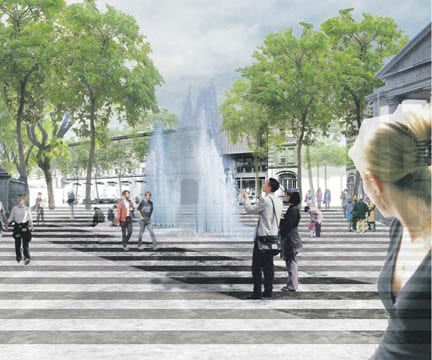 Castle is key part of new plan
Castle is key part of new plan
A CITY architect has come up with a riverfront initiative to enhance the impending refurbishment of King John’s Castle.
The focus of his project is a linking together of the three most important historic buildings in the city – the Hunt Museum, St Mary’s Cathedral and King John’s Castle.
Speaking to the Limerick Post, the landscape architect, Dan Sheedy, says that by using the spaces around these buildings, “you can tell the story of the city and its transformation from a Viking market town to a modern European city.
“At the moment, despite proximity, this stretch of the riverfront, from Sarsfield House to the castle, is really fragmented.
“I decided to do a kind of sketch masterplan of the whole site.
Conceding that many of the changes he recommends have been proposed before in some form or other, he says:
“it’s not a radical new concept plan, in that sense”.
Emphasising that his plan is more about building on the area’s positive aspects, from an urban/landscape designer’s perspective, while at the same time addressing some of the underlying built environment issues that hold the area back, he says:
“While the castle is a key part of the project, Nicholas Street isn’t considered except in relation to an idea I have for the castle and the surrounding area which involves the establishment of a bimonthly national antiques fair along the lines of the Fiera Anitquaria, at Arezzo in Italy”.
Stressing the importance of “active streets,” Mr Sheedy says that successful city areas require a variety of uses in order to ensure they are active from morning to night, throughout the week, including weekends.
`”A good time-spread means people are using the spaces at different times of the day and on different days of the week.
“Peopled spaces and streets feel safer and draw others in, and where there is a lack of buildings within a site area this lessens sustainable activity throughout the week, – this failing contributes greatly to the severance issues affecting King John’s castle and the Nicholas Street area”.
Mr Sheedy has produced a plan that attempts to address this problem with a series of strategically sited new developments that would draw people in significant numbers.
“It would also maintain a sufficient volume of users well into the evening and at the weekends,” he says.
Pointing out that people feel safer knowing there are opportunities to steer clear of a potential threat, the Limerick city architect says that the waterfront promenade from the courthouse to King John’s castle, lacks an adequate number of “escape routes to allay people’s fears in this regard.
“Lots of streets and cross-street interconnectors mean that traffic streams pool at street corners and create the necessary conditions for commerce and social interaction”.
Referring to recent proposals to open up the castle to through-traffic on special occasions, he agrees this is in keeping with the aim to integrate the castle, its grounds and medieval surroundings into the overall fabric of the city.
Critical of the “isolated park-like spaces around the Hunt Museum, the civic buildings and the castle, he says the most effective design solution in this case is a knitting” strategy, “where new spaces and buildings are meshed into an existing underlying urban structure, which has the benefit of giving continuity”.
Mr Sheedy’s masterplan aims to build on the “open-closed” pattern also on the waterfront.
“The overall effect would be a series of narrow streets and allées (tree avenues), punctuated with enclosed spaces.
“Trees also play an important role – used correctly in an urban context, tree stems and canopies enclose space, both horizontally and vertically – tree centres are included on the plans but it is vital that the correct species are chosen and that they are spaced appropriately and pruned correctly when used for this purpose”.
Mr Sheedy’s project will be on view on information panels in the city library in the Granary until the end of July.





